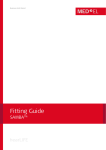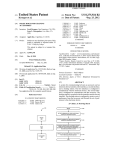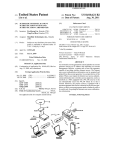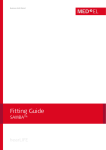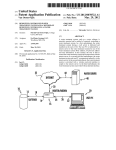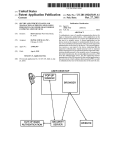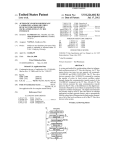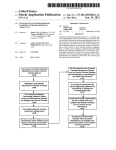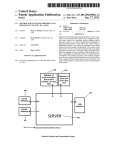Download Multi-Factor Authorization System and Method
Transcript
US 20100063935A1
(19) United States
(12) Patent Application Publication (10) Pub. No.: US 2010/0063935 A1
(43) Pub. Date:
Thomas et al.
(54)
MULTI-FACTOR AUTHORIZATION SYSTEM
(60) Provisional application No. 61/095,290, ?led on Sep.
8, 2008.
AND METHOD
(75) Inventors:
Mar. 11, 2010
Ajit Thomas, San Francisco, CA
(US); Rodney Robinson, Los Altos
Hills, CA (US); John Michael
Tumminaro, Mountain View, CA
(US); John Tumminaro, Palo Alto,
CA (US)
Publication Classi?cation
(51)
Int. Cl.
G06Q 10/00
(52)
(2006.01)
US. Cl. ...................................................... .. 705/325
Correspondence Address:
Law Of?ces of James E. Eakin
PO. Box 1250
(57)
Menlo Park, CA 94026 (US)
(73) Assignee:
Method and system for authenticating the identity of a party
to a transaction being executing over wired or wireless net
Obopay, Inc., Redwood City, CA
works, using a personal device. A transaction system is
(Us)
(21) Appl. No.:
(22) Filed:
adapted to receive messages over a network from a connected
device, where the messages are intended to initiate a transac
12/555,772
Sep. 8, 2009
tion. The system comprises authentication rules and an asso
ciated engine for identifying the type of transaction and, for
each type of transaction, whether MFA is required. If so, the
necessary MFA attributes are requested, thus permitting
Related US. Application Data
(63)
ABSTRACT
completion of the transaction in a comparatively secure man
ner and also permitting management of the accounts associ
ated with the party.
Continuation of application No. 11/694,747, ?led on
Mar. 30, 2007, Continuation of application No.
12/470,482, ?led on May 21, 2009.
100
105
Capture Phone Number
110
User Selects Sign Up
i
115
Collect User Date
120
125
PUSH SMS sent. containing
security string
...............
130
PUSH SMS wakes
application
................
135
Device Calts Back {0 System
140
System confirms device
Patent Application Publication
Mar. 11, 2010 Sheet 2 0f7
Figure 2
100
Launch application
105
Capture Phone Number
110
User Selects Sign Up
115
Collect User Data
120
Set Mobile PIN
ii
125
PUSH SMS sent, containing
security string
V
130
PUSH SMS wakes
application
135
Device Calls Back to System
140
System confirms device
US 2010/0063935 A1
Patent Application Publication
Mar. 11, 2010 Sheet 3 of7
Figure 3
200
Access WAP-enabled site
205
User Log in
210
Select Transaction Type
V
215
Enter Recipient Data and
Transaction Amount
220
User Receives IVR Call
V
225
User confirms transaction,
enters PEN
V
230
Upon PIN verification,
Transaction completes
US 2010/0063935 A1
Patent Application Publication
Mar. 11, 2010 Sheet 5 0f 7
US 2010/0063935 A1
Mar. 11, 2010
US 2010/0063935 A1
MULTI-FAC TOR AUTHORIZATION SYSTEM
AND METHOD
RELATED APPLICATIONS
[0001] The present application is related to, and claims the
bene?t under 35 USC Section 119 of, US. provisional Patent
Application Ser. No. 61/095,290, ?led Sep. 8, 2008, entitled
Multi-Factor Authorization System and Method, as Well as
US. patent application Ser. No. 11/694,747, ?led Mar. 30,
2007, entitled Mobile Person-to-Person Payment System,
and US. patent application Ser. No. 12/470,482, ?led May
21, 2009, entitled Mobile Person-to-Person Payment System,
all of Which are incorporated herein by reference.
FIELD OF THE INVENTION
[0002]
This application relates generally to methods and
techniques for authenticating the identity of a party to a trans
action, and more particularly relates to methods and tech
niques for authenticating the identity of a person executing a
transaction over Wired or Wireless netWorks, using a personal
device. This invention applies throughout the lifecycle of
portable computing device can be equipped With a client
softWare or Widgets utiliZing such programming technology
as J2ME, BREW or other equivalent technology; and can
access on-line data and services such as mobile internet pages
or WAP enabled Web pages, or IVR enabled services.
[0007] In an embodiment, the system of the present inven
tion includes authentication rules and a con?guration engine
to identify Which authentication rules need to be applied for
various transactions and activities, depending on the stage of
the life cycle of the associated accounts, on the ?nancial risk
associated With the transaction or activity, and the access
channel used to complete the transaction or activity.
[0008] In an embodiment, the system of the present inven
tion can include a plurality of repositories storing information
used in completing a multi-factor authentication, Where such
repositories are associated With systems to identify a personal
computing device; or With systems to identify a netWork
connection service (such as a broadband or Wireless service);
or With systems to store the name and address of a person
participating in a transaction; or With the systems for manag
ing a communications netWork.
One dif?culty in managing accounts and conducting
[0009] In another embodiment, the system of the present
invention includes an authentication processing engine used
to complete authentication rules processing; to address
authentication requests to the plurality of repositories used to
store authentication information; and to determine the result
?nancial transactions via electronic netWorks is the challenge
of verifying that the person conducting the transaction is
tial analysis of the result of each individual authentication
actually authorized to perform the transaction in question.
request.
The dif?culty of authenticating the identity of a person con
ducting such a transaction has led to the proposal of many
different sorts of authentication and veri?cation techniques,
most of Which offer limited utility, particularly for transac
present invention can be used to secure the registration and/or
activation of a neW service account; the transfer of moneys or
either or both the transaction and the associated accounts.
BACKGROUND OF THE INVENTION
[0003]
tions conducted over a Wireless netWork, such as transactions
conducted from a mobile phone.
[0004]
Thus, there has been a long-felt need for methods
and techniques for e?iciently and reliably authenticating the
identity of those transacting netWork-based business.
SUMMARY OF THE INVENTION
[0005]
The present invention provides a con?gurable sys
of the authentication process based on the conjoint or sequen
[0010]
In an embodiment, the system and technique of the
?nancial assets; the payment of goods and services; the can
cellation or closure of an account; the completion of a cus
tomer service request such as a balance inquiry, a service
inquiry, or a service upgrade. Those skilled in the art Will
recogniZe that such multi-factor authentication methods, sys
tem and technique can be used on a variety of transactions
performed over netWorks and carrying a certain ?nancial risk
if the participants Were not uniquely identi?ed and authenti
cated.
[0011]
In an embodiment, the techniques of the present
tem and methods for implementing multi-factor authentica
tion (“MFA”) for protection of transactions and customer
information When transactions are being conducted through
any of a variety of channels, utiliZing a consumer personal
invention are used to provide secure enrollment in a service
using, as one example, a J2ME-enabled handset. In such an
computing device, communicating through data netWorks
a PIN (personal identi?cation number, although the PIN can
such as the Internet, or proprietary netWorks, utiliZing such
transport mechanism as voice communication services,
broadband data services, Wireless data services, SMS, AIM or
other instant messaging services, over such protocols as TCP/
be any character string and not just numbers). Then, depend
ing upon the version of J 2ME supported by the handset, either
IP, or proprietary data transport protocols.
[0006] The implementations associated With each channel
“push” SMS is not available, transmission of an SMS mes
sage With a veri?cation code folloWed by the user’s manual
check for “something the user knoWs, and something the user
has” to maintain and verify the authenticity of the user and
therefore to secure private information and transaction capa
bility. Such authentication methods can include the veri?ca
tion of: a PIN or Passcode; the phone number, serial number,
secure element ID associated With the mobile device or per
embodiment, data is collected, including input by the user of
a “push” SMS or a manual SMS is sent to the handset. If a
“push” SMS, a veri?cation is managed automatically; When a
entry of that veri?cation code permits completion of the MFA
process.
[0012] In a similar manner, MFA processes using BREW,
WAP, SMS and Web-based platforms are provided in accor
dance With the invention. In connection With payment or
money transfer transactions, instances in Which MFA proce
dures are appropriate comprise the foregoing sign-up process,
sonal portable device used in the transaction; the IP address of
the data connection; the geographical location of the IP
address; the geographical location of the portable device as
and also various user processes including sending of funds
determined by the netWork it is connected to or by a Global
request from a third party), loading a prepaid account, login
Positionning System functionality; the name of the account
holder as registered by a third party service provider. The
using an unregistered device [i.e., a device different than the
user’s knoWn and validated device(s)], and a one-time pickup
(Whether user-initiated or in response to a “send money”
Mar. 11, 2010
US 2010/0063935 A1
the sending user not only knoWs a secret such as a PIN or a
deployed in the ?eld; or the system 40E managing the net
Work through Which the Personal Computing Device is
accessing the service for Which the transaction is performed;
Passcode, but also has physical possession of the device, such
or the third party authentication service 40G and associated
of funds. In part, the MFA process ensures that, for appropri
ate transactions, for example those in Which money is sent,
as a handset, being used to initiate and con?rm the transac
tion.
THE FIGURES
[0013] FIG. 1 illustrates the general architecture of multi
factor authentication in accordance With the present inven
tion.
[0014] FIG. 2 illustrates in logic ?oW diagram form an
embodiment of an MFA process in accordance With the inven
tion.
[0015] FIG. 3 illustrates in logic ?oW diagram from an
embodiment of an MFA process using WAP in accordance
With the invention.
[0016] FIG. 4 illustrates in How diagram form an overvieW
of an embodiment for managing transactions involving multi
factor authentication With callbacks.
[0017] FIG. 5 illustrates in logic ?oW diagram form an
MFA process performed at the transaction level using WAP/
SMS.
[0018] FIG. 6 illustrates in a high level diagram the steps to
implement MFA for various channels and platforms, in accor
dance With the foregoing Figures.
[0019]
FIG. 7 illustrates an embodiment of a Multi-factor
Authentication Con?gurations and Rules Engine.
DETAILED DESCRIPTION OF THE INVENTION
[0020] Referring ?rst to FIG. 1, there is shoWn therein an
embodiment of a multi-factor authentication system identi
fying the various architectural elements involved in complet
ing a Multi-factor authentication request. User 5 accesses a
Transaction System 15 through a Personal Computing Device
data store 40H. Each Repository responds to the authentica
tion request With any query to the User 5 or Personal Com
puting Device 10 necessary to authentication such user or
device. Upon receiving a response the Repository 40 vali
dates the identity of user 5 or the device and provides the
Authentication Processing Engine 20 With a response to the
authentication request.
[0022] The sequence described here above is illustrative
only and a person skilled in the art Will recogniZe that the
communications betWeen the various systems of the present
invention can be implemented in a number of Ways, such that
the foregoing description is not intended to be limiting.
Rather, the present invention is to be limited only by the
appended claims. Likewise, those skilled in the art Will rec
ogniZe that the functionalities of the various systems can all
be incorporated into a single server or distributed across mul
tiple servers. LikeWise, the repositories and data stores can
reside in a single database, or multiple databases in a single
repository, or canbe distributed across multiple databases and
multiple repositories.
[0023] Referring next to FIG. 2, an embodiment of an MFA
process is illustrated in the context of user sign-up. Although
the present invention encompasses the use of various plat
forms and personal computing device technology (including
J2ME, BREW, WAP, and so on), for purposes of clarity the
embodiment illustrated in FIG. 2 involves a J2ME platform,
otherWise knoWn as Java ME or a mobile and embedded Java
platform.
[0024] As noted above, the illustrated process is for user
signup from such a handset, and starts at step 100 With the
launching of an application resident on the handset. The
application can be preloaded on the handset by the manufac
10 to obtain a service. The Personal Computing Device can be
turer, doWnloaded by the user or carrier, or installed on the
a mobile phone capable of SMS communications, or capable
of broWsing mobile internet pages, or capable of executing
applications; or a personal device capable of broWsing the
handset in any convenient manner. FolloWing launch of the
internet for instance using a WiFi connection to an Internet
connected access point; or a regular phone used to access a
automated voice response system or an operator; or a Per
application by the user, at step 105 the phone number of the
handset is pulled from the device to the system of the present
invention, such as that described in US. patent application
Ser. No. 11/694,747, ?led Mar. 30, 2007, entitled Mobile
Person-to-Person Payment System, orU.S. patent application
sonal computer capable of broWsing the internet, executing
local applications or executing Widgets. Transaction System
Ser. No. 12/470,482, ?led May 21, 2009, having the same
time, both of Which are commonly assigned and incorporated
15 inquires from the Multi-factor Authentication Con?gura
tions and Rules Engine 30 the type of authentication required
herein by reference. The application can, in some embodi
in order to secure the transaction.
[0021]
The MFA Con?gurations and Rules Engine 30
accesses the MFA Rules and Con?guration Store 35 Where
the information to process the authentication processed is
stored. FIG. 7, discussed hereinafter, illustrates examples if
transaction services 35A, transaction types 35B, and method
sets 35C. Upon selection of the proper authentication require
ment, the Transaction System 15, interfaces With the Authen
tication Processing Engine 20, to complete the authentication
process. The Authentication Processing Engine 020 sends
authentication requests to the various Systems and Reposito
ments, require that the user enter the phone number, although
in other embodiments the phone number can be automatically
retrieved from the device. In addition, in most embodiments
the phone number is communicated to the system in a secure
manner.
[0025] FolloWing capture of the phone number, Which in
other embodiments could alternatively be any other indicia
unique to the device or the user, the application offers the user
the opportunity to sign up, or register, With the system. The
user then selects “Sign Up”, as shoWn at step 110, after Which
ries 40A-40H Which can comprise authentication information
appropriate user data is collected as shoWn at step 115.
Depending upon the device and the nature of the data appro
priate for the particular embodiment, the user can be required
system and repositories 40. Such systems and repositories
to enter the user data or, if the data resides in the device at an
40A-40H can include the service management system 40C of
either the transaction provider, and/or the mobile service pro
vider, and/or a ?nancial services provider; as Well as the
the user data to the system. Then, at step 120, the user selects
system 40A managing the Personal Computing Devices
PassCode can comprise a multi-character string, for example
accessible location, the application can capture and transmit
and enters a PIN or PassCode. In an embodiment, the PIN or
Mar. 11, 2010
US 2010/0063935 A1
six numerals, or a series of hex numerals, or any other string
of characters understandable by the system. The PIN or Pass
Code is transmitted to and stored in the system, typically in
encrypted form, and then, as shoWn at step 125, the system
transmits a “push” SMS message to the phone number cap
tured at step 105. The SMS message typically comprises at
least a security string.
[0026] In MIDP (Mobile Information Device Pro?le) 2.0
devices or similarly capable devices, the pushed SMS “Wakes
up” the application as shoWn at 130, and the application then
calls, sends back a message, or otherWise communicates the
security string or other con?rming indicia to the system, as
shoWn at 135. The successful exchange of communications
con?rms the device, as shoWn at step 140. It Will be appreci
ated that other steps, not important to the invention, have been
omitted for clarity. Such steps can include, for example,
requiring the user to accept various contractual provisions,
terms and conditions.
[0027]
In other embodiments, such as those implemented
on MIDP 1.0 J2ME devices or similarly capable devices, a
manual SMS message is transmitted from the system to the
device at step 125, rather than the “push” SMS shoWn in FIG.
2. In such an arrangement, the manual SMS comprises at least
a security string, Which the user is then prompted to enter. The
security string entered by the user is transmitted to the system,
permitting con?rmation of the device in substantially the
card or a bank account (including ACH transfers), or the
purchase of an item, or a response to a request for money from
a third party. As With the process illustrated in FIG. 2, for
purposes of clarity the process illustrated in FIG. 3 omits
steps not important to an understanding of the invention,
including, for example, a veri?cation that su?icient funds are
available, or offering the user alternative funding sources, and
so on.
[0031]
In systems using the SMS protocol for transactions,
MFA veri?cations can be performed in a manner similar to
that shoWn in FIG. 3. In an embodiment of such a process, the
user sends a message to a pre-de?ned number comprising the
“sen ” command, the recipient’s identi?cation, and the trans
action amount. Thereafter, the system initiates an IVR call to
the user, Who con?rms the transaction as With the WAP pro
cess described above. Once the con?rmation data is veri?ed,
the transaction completes. Other transactions, including
“requests for money”, “accept money”, and “get money”, can
all be handled in a substantially similar manner, Where the key
elements are the indicia unique to the transaction, folloWed by
an IVR call to con?rm at least some of those details, With the
transaction completing once the con?rmation data is veri?ed.
It Will be appreciated that the con?rmation occurs substan
tially instantaneously, making the con?rmation process user
friendly While maintaining near-real-time operation of the
present system.
same manner as shoWn in FIG. 2.
[0032]
[0028]
In an embodiment, a similar process is used for login
tion can be used for viral transactions, or transactions in
Where the user’s device has not been registered, for example,
?rst time login from the Wireless device Where sign-up
Which a recipient of funds is not otherWise registered With the
system. In such an arrangement, the unregistered user
occurred on a different channel, or Where there is some other
reason to require authentication. In an embodiment for such a
accesses the system via any convenient channel, such as the
Web, and selects a “pick up money” transaction. The user then
process, the user launches the application as shoWn in FIG. 2,
enters appropriate personal information to verify identify,
along With information identifying Where their funds should
and the user selects “log in” instead of “sign up” at step 110.
For MIDP 2.0 J2ME devices, the process of FIG. 2 proceeds
substantially as shoWn, including the use of a “push” SMS
With a security string, folloWed by automatic Waking of the
application and transmission back to the system. As With
signup, the process for MIDP 1.0 J2ME devices is also similar
In addition, the MFA process of the present inven
be sent, such as an account at a ?nancial institution, a check
mailed to their address, or other disposition. The system
communicates to the user’s device a temporary PIN, and then
calls the device. The user enters the temporary PIN, permit
ting the system to complete the transaction.
in at least some embodiments, Where the user is sent a manual
[0033]
SMS message With a security string, and the user must enter
ment for managing transactions involving multi-factor
Referring next to FIG. 4, an overvieW of an embodi
the security string to permit authentication to complete.
[0029] Transactions involving the WAP protocol can, in
authentication With callbacks is illustrated in process How
form. Steps indicated With a dashed line occur asynchro
some embodiments of the invention, involve an IVR callback,
as shoWn in FIG. 3. The process starts With the user accessing
a WAP-enabled Website, as shoWn at 200. The user then logs
nously. The services provided by system applications are
indicated as AS, While business services are indicated as BS.
number together With their PIN, as shoWn at 205. The system
It Will be appreciated that the embodiment of the MFA “call
back” itself can be facilitated via any number of protocols/
channels/identities such as SMS, IVR, email, IM, etc.
presents the user With one or more transaction types, and the
user selects the appropriate one as shoWn at 210. The user
IVR process can be better appreciated. When the user ansWers
then enters the recipient’s, together With the transaction
the IVR call, a Welcome message is played, displayed or
in, typically by providing a unique indicia such as their phone
amount, as shoWn at 215, and this information is transmitted
to the system. The system then initiates an IVR call to the
user’s device, shoWn at 220. Depending upon the particular
embodiment, a text-to-speech system can be used to convert
the user’s spoken Word into data, or keypad entries can be
used, but in either event the user is prompted to con?rm the
transaction, typically by con?rming the transaction amount
together With re-entering their PIN, as shoWn at 225. Once the
con?rmation is veri?ed, the transaction completes as shoWn
[0034]
Referring next to FIG. 5, the phone con?rmation
otherWise communicated as shoWn 400. If the user enters a
key not permitted in their PIN, or otherWise fails to proceed
properly, the call terminates at Mobile Fail 1, shoWn at 405.
HoWever, if the user begins entry of a PIN, a check is made at
415 to determine Whether their account is locked. If it is, an
error occurs at step 420 and the transaction cancels at step
425.
[0035] If the account is not locked, the process advances to
step 430, Where a check is made to see Whether the PIN
at 230.
entered by the user has an appropriate number of digits. If not,
[0030] Other types of transactions can be performed using
a WAP protocol With IVR callback, including loading (“add
an error is indicated at 435, and the process loops to 410, after
Which the user is permitted to enter their PIN again. If the user
makes repeated PIN entry errors, the account is locked and the
ing funds to”) a prepaid card or account using either a credit
Mar. 11, 2010
US 2010/0063935 A1
transaction cancels at 425. If the user enters a proper number
and legal liabilities require that certain degrees of authenti
of digits, but still the Wrong PIN, an error is noted at 440 and
the user is invited to reenter their PIN. In some embodiments,
lock-out occurs immediately Where the number of characters
cation be performed to manage the risks associated With the
transactions.
is too feW, Whereas multiple tries are permitted before lockout
Where the number of digits is closer to correct.
[0036] HoWever, in most cases the PIN is correct, and the
process advances to step 445. A general error can still occurs,
as noted at 450, resulting in a hang-up as shoWn at 455 and
460. HoWever, Where the PIN is correct and no other failure
occurs, the process advances to step 465 and the transaction
[0039] Examples of Transaction Types for each of the Ser
vices supported include all aspects of the management of the
lifecycle of a transaction or an account, including the initial
registration for the service; the activation of the account and
the delivery of the ?rst transaction; the normal use of the
account and the service; the servicing of the account through
activities such as balance inquiries, account information
updates, statements, etc . . . ; and the servicing of the account
in exception situations such as a reversal of a transaction, the
completes at 470, including a hangup.
blocking of an account, the closure of an account, etc . . .
[0037]
[0040] Examples of MFA methods include PIN or Pass
code validation; identity validation such as name, address,
Next, FIG. 6 depicts an embodiment of the system of
the present invention Where the service access is for Person to
Person money transfer, across a variety of channels, for Which
different authentication rules are required. Referring to FIG.
6, the types of channels Where MFA is not required is indi
cated by a holloW star, Whereas channels Where MFA are
required are indicated by a solid star. In addition, the need to
perform MFA using an IVR call is shoWn by the suspend
resume process shoWn in the steps at the upper right of FIG.
6. It Will also be appreciated that IVR is available as an
independent channel for performing MFA.
[0038]
Referring to FIG. 7, an embodiment of the Multi
social security number, drivers license number; serial number
of the device or a secure element contained in the device;
phone number or IP address associated With the device; loca
tion of the Personal Computing Device at the time of the
transaction, etc . . .Authentications may include a query to the
user of the service, a call back or message back to validate the
origin of the transaction, a query to the Personal Computing
Device, and/or a query to a 3rd party provider holding infor
mation associated With the identity of the user or of the
Personal Computing Device.
[0041] Having fully described a preferred embodiment of
factor Authentication Con?gurations and Rules Engine 30 is
illustrated. It is understood that the MFA Con?gurations and
Rules Engine 030 and Associated MFA Rules and Con?gu
the invention and various alternatives, those skilled in the art
rations Stores 035 is composed of one or a plurality of servers
the invention. It is therefore intended that the invention not be
and associated databases, that are located and managed either
by a transactional service provider or by a third party authen
limited by the foregoing description, but only by the
appended claims.
tication provider contracted by such transactional service
provider to provide high assurance authentication services. In
a typical arrangement, the third party authentication provider
We claim:
1. A method for authenticating the identity of a party to a
transaction being executed over Wired or Wireless netWorks,
provides such MFA services to a plurality of transactional
using a personal device, comprising the steps of
service providers. The MFA Con?guration and Rules Engine
030 utiliZes a set of tables or data structures describing, for
each service, the type of transaction included in the service
delivery. An exemplary embodiment is shoWn in FIG. 7 as
Transaction Service Table 035A, together With tables or data
structures, an exemplary embodiment of Which is the Trans
action Table Types Table 035B, Which describe the rules
associated With each transaction types. Included among such
Will recogniZe, given the teachings herein, that numerous
alternatives and equivalents exist Which do not depart from
receiving, over a netWork, a message to initiate one of a
plurality of transactions,
identifying at least one indicia of the device transmitting
the message,
identifying the type of transaction, Where at least one of the
plurality of transactions requires further authentication
and at least another one of the plurality of transactions
rules is Whether a Multi-Factor Authentication needs to be
does not,
applying a set of rules appropriate to the transaction,
performed, and the sets of equivalent authentications Which
for transactions requiring further authentication, compar
must be completed. In an embodiment, the authentication
ing the party’s response to predetermined acceptable
methods required are described in a set of tables or data
responses, and
structures, such as shoWn by MFA Method Set Table 035C,
accepting or rejecting the transaction request depending
identifying the participating repository, the type of authenti
upon the outcome of the comparison.
2. A system for authenticating the identity of a party to a
cation performed, and the acceptable outcome of the authen
tication. Examples of Transaction Services that can utiliZe the
present invention include information services such as spe
cialiZed Weather services (sailing, ?ying . . . ), stock and
?nancial market tickers, sports tickers . . . ; Top-Up services
for prepaid utilities; Account to Account money transfers;
Person-to-Person money transfers and remittances; Bill pay
ment services and merchant account payment services; Non
public information transfer services (such as health informa
tion, identity information); or any services the utiliZation of
Which gives rise to a series of transaction With registered and
un-registered users, for Which the actual or potential ?nancial
transaction comprising
a transaction engine for receiving messages requesting that
a transaction be initiated, and identifying the type of
transaction being requested,
at least one repository for storing sets of rules for authen
ticating a party depending upon the type of transaction
requested, and
a rules engine for identifying a set of rules applicable to the
requested transaction and applying the applicable rules.
*
*
*
*
*













